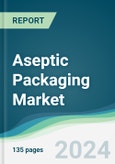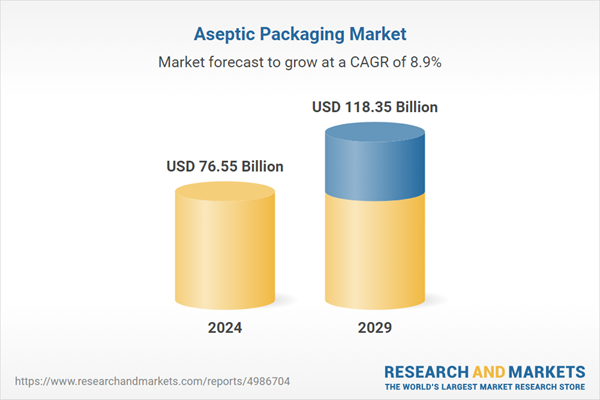The aseptic packaging market is expected to grow at a CAGR of 8.94%, reaching a market size of US$118.357 billion in 2029 from US$76.559 billion in 2024.
Aseptic packaging involves filling sterile products into sterile containers in an environment like aseptic chambers. This method of packaging has resulted in an increased demand for aseptic packaging products in the food, beverage, and healthcare sectors. The growing food and beverage industry, coupled with a shifting trend toward food and beverages without preservatives, is expected to be the prime driver for the market growth during the forecast period.The packaging industry is expected to experience growth that reflects in the growth of the aseptic packaging market. Aseptic packaging helps food extend its shelf life while preventing it from smelling. It helps retain the fresh taste in milk whilst preventing its contamination. It relieves expense control by eliminating cold chain transport which saves money. The high cost of raw materials, presence of cheaper alternatives, government laws and regulations among other factors will slow down the increase in aseptic package sales.
Aseptic Packaging Market Drivers:
Shifting trends toward foods and beverages without preservatives
Preservatives have been widely used to extend the shelf life of products. However, many of the preservatives (200 series), approved by various food standard associations worldwide, are capable of causing multiple health hazards. This has led to people avoiding the adoption of products that use them. As an alternative, there are thermal sterilization techniques such as Ultra High Temperature (UHT) processing, which eliminates the use of preservatives. However, it requires pre-sterilized packaging solutions in the form of aseptic packaging, thus posing as a market driver. Furthermore, multiple food preservatives, such as sodium nitrate and sodium nitrite, have also been linked to cancer but are allowed in smaller quantities in many parts of the world. This has further increased the demand for avoiding any form of preservatives in foods and beverages and is snowballing the demand for other forms of treatment and aseptic packaging solutions for their packaging.High demand for paper form of packaging material
By packaging material, the aseptic packaging market is segmented as paper, plastic, glass, and metal. The paper will hold a significant market share and is projected to grow fastest, owing to the heavy government regulations regarding promoting renewable and sustainable packaging. Furthermore, the growing trend toward adopting renewable or easily disposable packaging materials is projected to drive the demand for paper-based packaging. For instance, in 2025, Australia will create packaging that is entirely made from renewable materials, including paper, that can be thrown away, recycled, or converted into compost, and this decision will have a positive impact on the need for paper-based aseptic packing. Plastics and glass are also used in many industries, which will still hold significant market share. These substances perform different roles in the production of foodstuffs and drinks as well as drugs, healthcare goods, and beauty products, among others. Metals are projected to hold a nominal market share and are also seen to grow the slowest.High demand for aseptic bottles
The Bottle holds a significant market share due to the increasing demand for convenience and quality products and the increasing urban population in developing countries. Aseptically filled bottles are easy to handle, resalable, and shock-resistant. They are also a good way of standing out from the competition on the shelf with a new way of expanding the refrigerated milk and milk beverage market. Cartons and boxes are available in many different forms and fulfill different purposes in the packaging industry. One of the benefits of aseptic packaging is that it makes the product shelf-stable under ambient conditions. Hence why it’s considered the modern progressive packaging medium. Ampoules, syringes, and vials are widely used in the pharmaceutical and healthcare industries. They are expected to grow significantly due to increasing healthcare awareness and growing investment in the pharmaceutical sector during the forecast period.Aseptic Packaging Market Restraint:
High investment cost
The high investment needed for design and during various production and distribution stages is restraining the market. Moreover, regional variances in plastic regulations complicate food and beverage product transportation. In addition, underdeveloped technology puts the market at further risk since it necessitates higher R&D and product development expenditures. Moreover, most of this packaging is composed of plastic, which negatively affects the environment by contaminating the soil and water. These factors' cumulative effect is limiting the market for this kind of packaging.Aseptic Packaging Market Geographical Outlook
Asia Pacific is expected to grow rapidly during the forecast period.
China ranks among the Asia-Pacific region's top consumers of aseptic packaging. During the projected period, the market's growth is expected to be supported by the rising consumption of food and beverages. The country's market is being driven by several notable factors, including the growing popularity of packaged meals, the expansion of eateries and supermarkets, and the rise in the consumption of bottled water and other beverages. India's industry is propelled by the country's expanding population, rising income levels, and evolving lifestyles. The rigid plastic packaging industry is seeing an increase in demand due to the growth prospects of end-user segments. Furthermore, the growing usage of pouch packaging alternatives limits the market's ability to expand its product line.Aseptic Packaging Market Developments:
- In February 2023, SIG established its first sterile carton plant in India, the world's largest milk market and leading juice manufacturer. The plant was established in Ahmedabad, the largest city in Gujarat. The entire cost was incurred to ensure that aseptic carton package manufacturing could utilize modern technology while maintaining high standards for all printing and finishing processes.
- In November 2022, Amcor PLC announced that it aims to convert all its aseptic products to recyclable ones. By 2025, Amcor should have succeeded in turning all its products into items that can be reused, composted, or preserved according to these three principles. Currently, 74% of the corporation’s total output mass can be regarded as recyclable material, while the volume of green-field propositions goes up regularly for this objective.
Aseptic Packaging Key Market Segmentation:
The aseptic packaging Market is segmented and analyzed as below:By Packaging Material
- Paper
- Plastic
- Glass
- Metal
By Product
- Bottles
- Cartons and Boxes
- Bags
- Pouches
- Syringes
- Vials & Ampoules
- Cans
- Others
By Application
- Food
- Beverage
- Pharmaceutical and Healthcare
- Others
By Geography
- North America
- USA
- Canada
- Mexico
- South America
- Brazil
- Argentina
- Others
- Europe
- UK
- Germany
- France
- Spain
- Others
- Middle East and Africa
- Saudi Arabia
- UAE
- Others
- Asia Pacific
- China
- Japan
- India
- South Korea
- Indonesia
- Others
Table of Contents
1. INTRODUCTION
2. RESEARCH METHODOLOGY
3. EXECUTIVE SUMMARY
4. MARKET DYNAMICS
5. ASEPTIC PACKAGING MARKET BY PACKAGING MATERIAL
6. ASEPTIC PACKAGING MARKET BY PRODUCT
7. ASEPTIC PACKAGING MARKET BY APPLICATION
8. ASEPTIC PACKAGING MARKET BY GEOGRAPHY
9. COMPETITIVE ENVIRONMENT AND ANALYSIS
10. COMPANY PROFILES
Companies Mentioned
- Shandong NewJF Technology Packaging Co., Ltd (Greatview Aseptic Packaging)
- Tetra Laval
- Amcor
- Ecolean AB
- Sealed Air Corporation
- Jet Technologies
- SIG
- DS Smith
- Carl-Zeiss-Stiftung (SCHOTT)
- Ferd (Elopak)
Methodology

LOADING...
Table Information
| Report Attribute | Details |
|---|---|
| No. of Pages | 135 |
| Published | August 2024 |
| Forecast Period | 2024 - 2029 |
| Estimated Market Value ( USD | $ 76.55 Billion |
| Forecasted Market Value ( USD | $ 118.35 Billion |
| Compound Annual Growth Rate | 8.9% |
| Regions Covered | Global |
| No. of Companies Mentioned | 10 |









